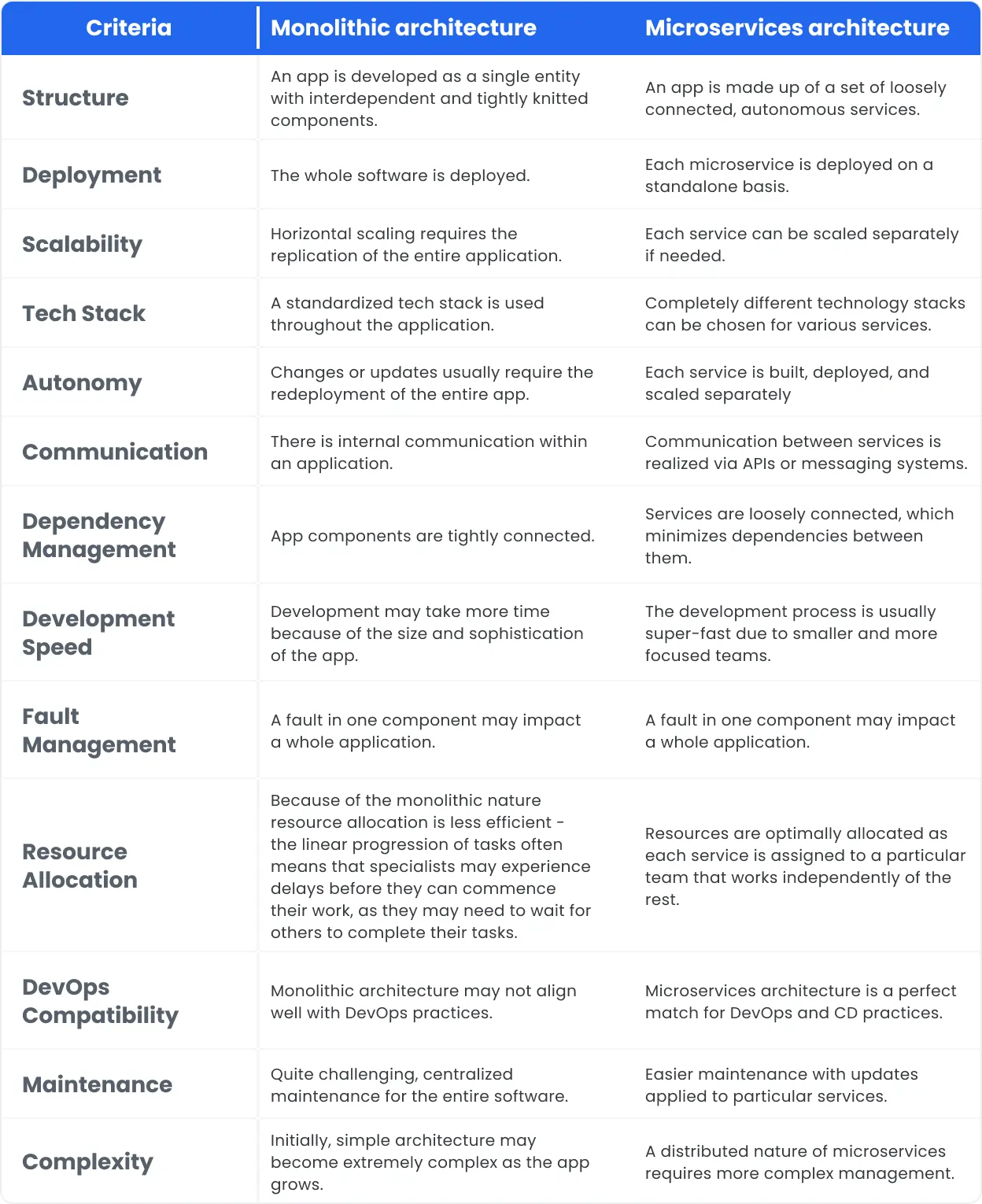9 minutes to read
Top 5 approaches to automated microservices testing


Chief Technology Officer
Agility, speed, and scalability are the three backbones of modern software development, and these are exactly what microservices architecture offers. So, no wonder, it is becoming more and more widely used. Its numerous benefits, particularly compliance with the DevOps philosophy make it a perfect choice for complex and large-scale projects.
Indeed, this type of architecture significantly simplifies software development, deployment, and maintenance. Still, on the flip side, it necessitates a special microservices test strategy.
Would you like to learn more details about microservices architecture and microservices test automation? Keep on reading — we are going to shed light on this topic so that you can streamline your QA and development processes.
What are microservices?
Microservices architecture is a great alternative to a monolithic pattern that imposes many constraints. The term ‘microservices’ was introduced in 2011 at a workshop by a group of software architects who had been exploring this architectural pattern for the last few years.
Microservices architecture has taken software development to the next level, by redefining the way complicated applications are designed, built, and deployed. Compared to the classic monolithic architecture that offers to develop an application as one entity, microservices architecture suggests building small, well-grained, autonomous, units that make up a whole application. Each of these units is accountable for a certain service. The connection between all these units or services is usually realized via RESTful APIs or messaging systems.
Decentralization is one of the core principles of microservices. Each microservice may use its own DB and server. On top of this, there is also the opportunity to opt for the most appropriate programming language, framework, and tech stack for each service. This enables autonomy, decreases the number of dependencies, and fosters scalability, as each service can be effortlessly scaled if needed.
This architectural approach also enables software engineers to build and deploy services independently, promoting utter agility and unprecedented flexibility in the development process. Various teams can completely independently work on diverse services. The modular structure and independent deployment make microservices architecture ideal for CI and DevOps practices, allowing teams to integrate code changes rapidly and consistently. The capability to deploy each service separately speeds up product delivery, enabling faster releases and updates.
Despite its multiple benefits, the microservices pattern comes with its own bunch of challenges. Managing communication between services, ensuring solid data consistency across all services, and implementing effective testing are some of the hurdles that companies regularly encounter.
Monolithic architecture VS microservices architecture
The best way to comprehend the value of microservices architecture is to compare it with the standard monolithic pattern. Indeed, the former is a far cry from the latter. Let’s have a look at the comparative table below.

The main difference between a microservice architecture and a monolithic one is that in the former, each process works as a separate loosely connected service with its own logic and DB. Scaling, updating, deploying, and testing are held within one module.
In a monolithic architecture, any change impacts the whole application, and more time is needed for debugging and checking. This usually results in rarer updates and more changes released all at once. This, in turn, maximizes the risks. There is also hardly any insulation in the monolith app. A problem or bug in a module can slow down or break the whole application.
Top 5 ways to automate microservices testing
Microservice testing is a holistic process that ensures adherence of microservices-based apps to a set of functional and non-functional requirements. Compared to a monolithic architectural pattern, microservices require a special strategy for automated testing.
In contemporary software development, the ‘shift-left’ methodology is deemed to be the most fitting strategy for testing microservices. It suggests introducing testing at the early stages of software development. Early and regular testing helps decrease the number of defects and enhance code quality.
Enhance the accuracy and security of your software ecosystem at its fundamental level with microservices testing
To comprehensively test applications built according to the microservices pattern, a bottom-up approach is recommended, involving various layers of testing:
1. Unit testing
The first layer is unit testing. It's a crucial aspect of the ‘shift-left’ methodology. Unit tests must cover approximately 90% of the code. It reduces the likelihood of potential errors in the subsequent phases. So, tests of this type are the most numerous and need to be automated. As a rule, the creation and execution of unit tests is a competency of developers.
Unit testing verifies separate tiny units of functionality in a microservice and checks the work of functions inside a microservice. All the dependent modules or test data are stubbed or mocked.
2. Component testing
The next layer is component testing. It focuses on verifying individual services that make up the whole app, ensuring that each microservice works as intended in isolation. In the course of component testing, the functionality and interactions of a particular microservice are meticulously checked, disregarding the larger ecosystem. So, the testing scope is a particular service and its internal components. Mocking or stubbing is applied to dependent microservices and DB responses.
There are four key aspects of component testing:
Functionality: Component testing validates that a microservice performs its specified functions accurately.
Interfaces: Component testing ensures adherence of the microservice APIs and interfaces to the predefined specs.
Data Flow: Component testing verifies a data flow within a microservice, including input processing and output generation.
Error Handling: Component testing checks the ability of a microservice to efficiently address errors, exceptions, and edge cases.
3. Contract testing
In microservices-based apps, a microservice providing a specific functionality acts as the provider. A microservice that consumes this functionality is called a consumer. A contract outlines the anticipated inputs, outputs, and work of both provider and consumer, serving as an official agreement between them.
Contract testing checks each microservice against a predefined contract, helping to pinpoint any discrepancies or communication issues at the initial stages of development.
The contract of a provider is tested to check if it is in line with expectations. A stub service may be used for simulating the consumer’s behavior. And vice versa, the consumer's contract is tested against the provider's real or stub service, ensuring compatibility of the consumer with the provider's contract.
By revealing compatibility issues between microservices at the outset of the development process, contract testing reduces the possibility of integration problems.
Pact, Pactflow, and Spring Cloud Contract are the most widely used microservices testing tools that can help you implement automated contract testing.
4. Integration testing
This type of testing validates the correct collaboration between multiple microservices, ensuring that they operate smoothly together as a cohesive system. Unlike component testing, integration testing extends beyond individual microservices to assess the communication pathways and data flow between interconnected services. This is one of the most significant tests for microservices-based apps. Its positive execution proves that software is designed correctly, and all individual microservices work as a complete product.
There are four key aspects of integration testing:
Interactions: Integration testing checks if microservices can efficiently communicate with each other through their defined interfaces.
Data Flow: Integration testing examines the data flow between microservices in diverse scenarios.
Synchronization: Integration testing checks if shared data or state is synchronized and consistent across microservices.
Error Handling: Integration testing checks how efficiently errors and exceptions are addressed when multiple microservices are involved.
5. End-to-end testing
Finally, the last layer is automated end-to-end testing that validates the functionality of the whole software by checking the work of all interconnected microservices. It mimics real-world scenarios, ensuring the seamless integration of various services.
Focus on real-world user scenarios lets e2e testing validate that the system as a whole functions as expected from the user's perspective.
This type of testing also verifies the data consistency and integrity across numerous microservices as well as assures the reliability and responsiveness of communication channels between microservices.
JBehave is a modern microservice testing framework that can be leveraged to automate end-to-end testing by taking user stories and verifying that the system behaves as anticipated.
Each of the testing layers contributes to the overall quality of microservices-based software. By systematically executing these tests, developers and QA engineers can detect and address defects early, ensuring the robustness and efficiency of microservices-based applications.
Conclusion
The whole history of software development is an ongoing improvement of efficiency and productivity that refers to both developed solutions and the development process itself. The emergence of the microservices architecture marks a pivotal breakthrough, enabling developers to significantly optimize processes and overcome complexities inherent in the traditional monolithic pattern.
Microservices, as a concept, advocates for building software as a suit of individual, independent services rather than a monolithic entity. This approach introduces unparalleled flexibility and scalability, transforming the software development industry. However, such a radical shift necessitates a specialized microservices testing strategy.
To achieve great results, it is recommended to employ the ‘shift-left’ methodology and automate tests at all layers. Automation of unit testing, component testing, contract testing, integration testing, and e2e testing deserve your particular attention when it comes to microservices testing.
Want to ensure your microservices architecture delivers on its promises of agility and scalability? Look no further than our expert microservices testing services. We leverage a multi-layered testing approach that goes beyond the approaches outlined in this article. Our team offers a comprehensive suite of testing solutions, from unit and integration testing to API and security testing, all designed to guarantee the smooth operation and seamless interaction of your microservices. Learn more about how we can empower your development process with robust microservices testing services.
Team up with an award-winning software QA and testing company
Trusted by 300+ clients worldwide
